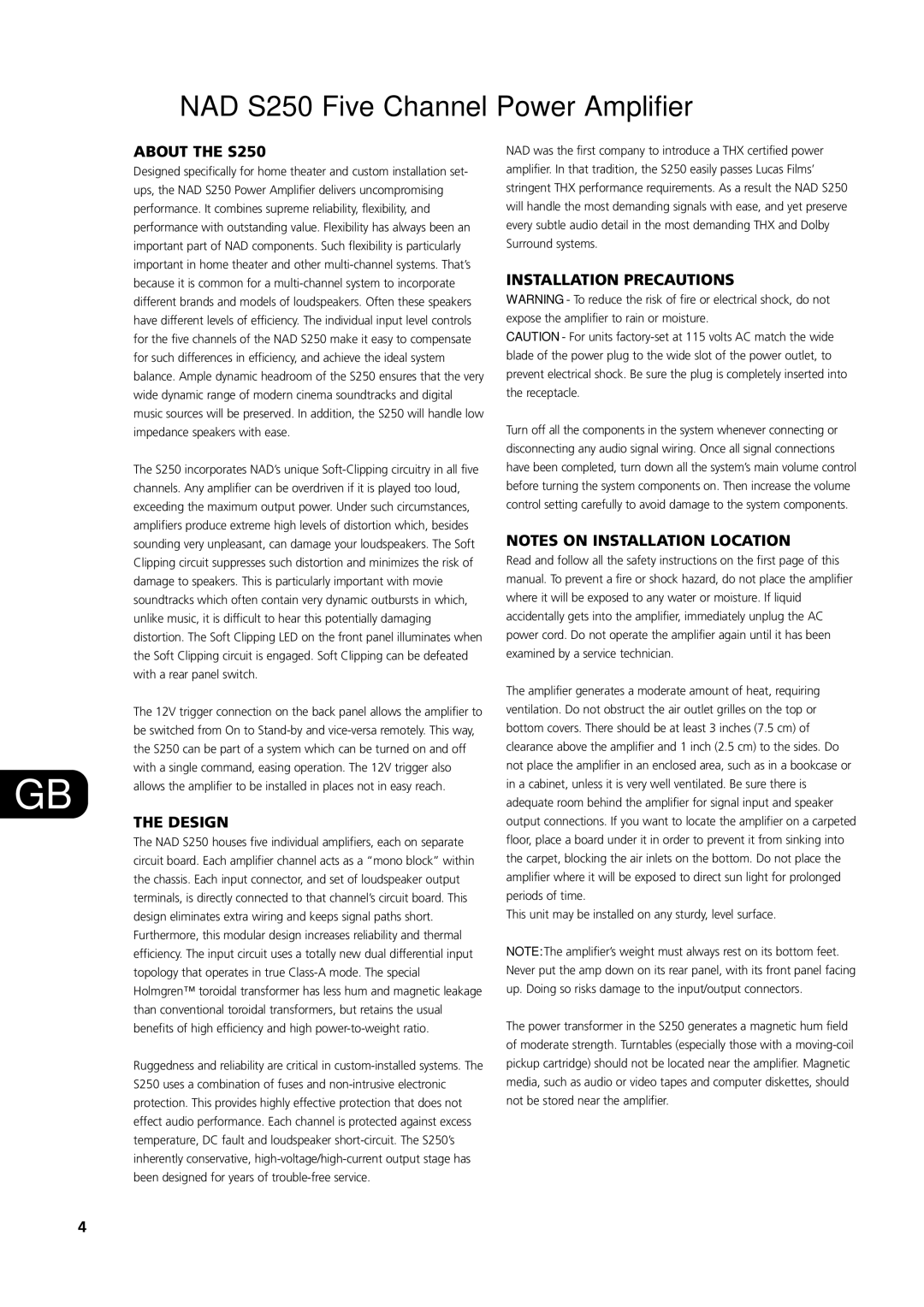ABOUT THE S250
Designed specifically for home theater and custom installation set- ups, the NAD S250 Power Amplifier delivers uncompromising performance. It combines supreme reliability, flexibility, and performance with outstanding value. Flexibility has always been an important part of NAD components. Such flexibility is particularly important in home theater and other multi-channel systems. That’s because it is common for a multi-channel system to incorporate different brands and models of loudspeakers. Often these speakers have different levels of efficiency. The individual input level controls for the five channels of the NAD S250 make it easy to compensate for such differences in efficiency, and achieve the ideal system balance. Ample dynamic headroom of the S250 ensures that the very wide dynamic range of modern cinema soundtracks and digital music sources will be preserved. In addition, the S250 will handle low impedance speakers with ease.
The S250 incorporates NAD’s unique Soft-Clipping circuitry in all five channels. Any amplifier can be overdriven if it is played too loud, exceeding the maximum output power. Under such circumstances, amplifiers produce extreme high levels of distortion which, besides sounding very unpleasant, can damage your loudspeakers. The Soft Clipping circuit suppresses such distortion and minimizes the risk of damage to speakers. This is particularly important with movie soundtracks which often contain very dynamic outbursts in which, unlike music, it is difficult to hear this potentially damaging distortion. The Soft Clipping LED on the front panel illuminates when the Soft Clipping circuit is engaged. Soft Clipping can be defeated with a rear panel switch.
The 12V trigger connection on the back panel allows the amplifier to be switched from On to Stand-by and vice-versa remotely. This way, the S250 can be part of a system which can be turned on and off with a single command, easing operation. The 12V trigger also
GB | allows the amplifier to be installed in places not in easy reach. |
|
| THE DESIGN |
| The NAD S250 houses five individual amplifiers, each on separate |
| circuit board. Each amplifier channel acts as a “mono block” within |
| the chassis. Each input connector, and set of loudspeaker output |
| terminals, is directly connected to that channel’s circuit board. This |
| design eliminates extra wiring and keeps signal paths short. |
| Furthermore, this modular design increases reliability and thermal |
| efficiency. The input circuit uses a totally new dual differential input |
| topology that operates in true Class-A mode. The special |
| Holmgren™ toroidal transformer has less hum and magnetic leakage |
| than conventional toroidal transformers, but retains the usual |
| benefits of high efficiency and high power-to-weight ratio. |
| Ruggedness and reliability are critical in custom-installed systems. The |
| S250 uses a combination of fuses and non-intrusive electronic |
| protection. This provides highly effective protection that does not |
| effect audio performance. Each channel is protected against excess |
| temperature, DC fault and loudspeaker short-circuit. The S250’s |
| inherently conservative, high-voltage/high-current output stage has |
| been designed for years of trouble-free service. |
NAD was the first company to introduce a THX certified power amplifier. In that tradition, the S250 easily passes Lucas Films’ stringent THX performance requirements. As a result the NAD S250 will handle the most demanding signals with ease, and yet preserve every subtle audio detail in the most demanding THX and Dolby Surround systems.
INSTALLATION PRECAUTIONS
WARNING - To reduce the risk of fire or electrical shock, do not expose the amplifier to rain or moisture.
CAUTION - For units factory-set at 115 volts AC match the wide blade of the power plug to the wide slot of the power outlet, to prevent electrical shock. Be sure the plug is completely inserted into the receptacle.
Turn off all the components in the system whenever connecting or disconnecting any audio signal wiring. Once all signal connections have been completed, turn down all the system’s main volume control before turning the system components on. Then increase the volume control setting carefully to avoid damage to the system components.
NOTES ON INSTALLATION LOCATION
Read and follow all the safety instructions on the first page of this manual. To prevent a fire or shock hazard, do not place the amplifier where it will be exposed to any water or moisture. If liquid accidentally gets into the amplifier, immediately unplug the AC power cord. Do not operate the amplifier again until it has been examined by a service technician.
The amplifier generates a moderate amount of heat, requiring ventilation. Do not obstruct the air outlet grilles on the top or bottom covers. There should be at least 3 inches (7.5 cm) of clearance above the amplifier and 1 inch (2.5 cm) to the sides. Do not place the amplifier in an enclosed area, such as in a bookcase or in a cabinet, unless it is very well ventilated. Be sure there is adequate room behind the amplifier for signal input and speaker output connections. If you want to locate the amplifier on a carpeted floor, place a board under it in order to prevent it from sinking into the carpet, blocking the air inlets on the bottom. Do not place the amplifier where it will be exposed to direct sun light for prolonged periods of time.
This unit may be installed on any sturdy, level surface.
NOTE: The amplifier’s weight must always rest on its bottom feet. Never put the amp down on its rear panel, with its front panel facing up. Doing so risks damage to the input/output connectors.
The power transformer in the S250 generates a magnetic hum field of moderate strength. Turntables (especially those with a moving-coil pickup cartridge) should not be located near the amplifier. Magnetic media, such as audio or video tapes and computer diskettes, should not be stored near the amplifier.

